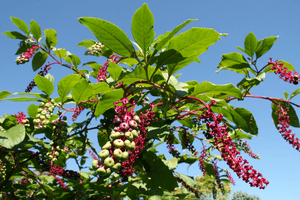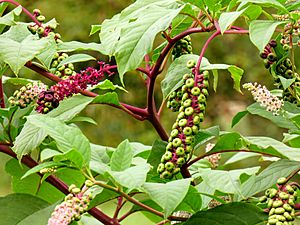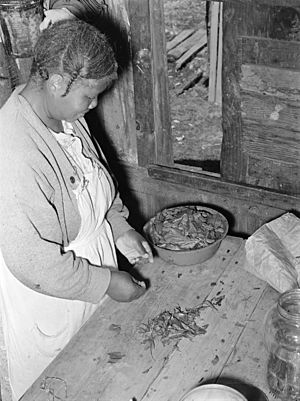American pokeweed facts for kids
Quick facts for kids American pokeweed |
|
|---|---|
 |
|
| Scientific classification | |
| Genus: |
Phytolacca
|
| Species: |
americana
|
| Synonyms | |
|
|
Phytolacca americana, also known as American pokeweed or just pokeweed, is a poisonous plant. It's a perennial plant, meaning it lives for more than two years. It can grow very tall, up to 8 feet (2.4 meters)! It has simple leaves and stems that can be green, red, or purplish. It also has a large white taproot (a main root that grows straight down).
Pokeweed flowers are green to white. After the flowers, purple to almost black berries grow. These berries are a food source for many songbirds like the gray catbird, northern mockingbird, and northern cardinal. Some small animals also eat them. These animals are not affected by the plant's toxins, which are harmful to humans and many other mammals.
Pokeweed naturally grows in eastern North America, the Midwest, and the Gulf Coast. You can also find it in parts of Europe and Asia where it has spread. Farmers often see it as a pest plant. Remember, pokeweed is poisonous to humans, dogs, and farm animals. In early spring, young shoots and leaves can be eaten if cooked very carefully. But later in the year, they become deadly. The berries are always poisonous. People sometimes grow pokeweed as an ornamental plant because its berries look nice. It's also studied for its natural chemicals, its role in nature, and its history in traditional medicine. You can often find it growing in fields, recently cleared areas, and along fencerows.
Contents
What is Pokeweed?
Pokeweed is a large herbaceous perennial plant that belongs to the Phytolaccaceae family. It can grow up to 8 feet (2.5 meters) tall in just one summer. From a thick, white root, one or more strong, smooth stems grow. These stems are usually green but can be purplish. The plant has simple leaves with long stems that grow in an alternating pattern along the main stem.
Pokeweed spreads only through its seeds. These seeds are large, shiny black, and shaped like a lens. They are found inside fleshy, purple-to-black berries that have bright crimson juice. The flowers are white or green and grow in long clusters called racemes. Each flower has 4-5 sepals (leaf-like parts that protect the bud) but no petals. The seeds can stay alive in the soil for many years before they sprout.
Birds are not harmed by the poisons in the berries, so they eat them and help spread the seeds. This is why you might find single pokeweed plants in areas where there aren't many others.
Other Names for Pokeweed
Phytolacca americana is known by many different names. Some common ones include pokeberry, poke root, Virginia poke, pigeonberry, inkberry, and redweed. In Chinese medicine, it is called chuíxù shānglù. When people talk about eating it, they often call it poke sallet or poke salad.
Is Pokeweed Dangerous?
All parts of the pokeweed plant can be harmful to humans and animals. The root has the most poison, followed by the leaves and stems. The ripe berries also contain toxins. The plant generally becomes more poisonous as it gets older, but the berries are dangerous even when they are green.
Children might be drawn to the bright clusters of berries. It's very important to know that:
- Children are most often poisoned by eating raw berries.
- Even a few raw berries can be very dangerous for young children.
- Adults have also been poisoned by eating leaves and shoots that were not prepared correctly. This can happen if part of the root is accidentally picked with the shoots.
- The plant's juice can be absorbed through your skin. So, you should avoid touching pokeweed with your bare hands.
Pokeweed should not be touched or eaten by pregnant people. If a child eats even one berry, they might need emergency medical help. The sap from the plant can also cause a skin rash in some people.
Birds seem to be immune to the poison. Most animals avoid eating pokeweed unless there is nothing else to eat. However, horses, sheep, and cattle have been poisoned by eating fresh leaves or contaminated hay. Pigs have been poisoned by eating the roots. If someone is severely poisoned, it can cause breathing problems.
In the 1800s, pokeweed poisoning was common in eastern North America. This was often because people used pokeweed in traditional remedies or mistook its roots for edible plants like parsnip.
Pokeweed in Nature and Gardens
Pokeweed berries are a good food source for many songbirds. These include the gray catbird, northern mockingbird, northern cardinal, and brown thrasher. Other birds like mourning doves and cedar waxwings also eat them. Some small mammals, such as raccoons, opossums, and foxes, can eat the berries without getting sick.
The larvae (young) of some moths, like the giant leopard moth, also feed on pokeweed.
Some people grow pokeweed in their gardens as an ornamental plant. They like its attractive berries. There are even special types of pokeweed grown for their larger berry clusters.
Can You Eat Pokeweed?
Poke is a traditional food in the southern Appalachian region. The leaves and stems of very young plants can be eaten, but only if they are cooked properly. This means boiling them two or more times, draining the water each time, and replacing it with fresh water. The leaves taste a bit like spinach, and the stems are similar to asparagus.
A common way to prepare it is to:
- Remove the leaves from a young plant.
- Rinse them in cool water.
- Boil them in a large pot for about 20 minutes.
- Throw out the cooking water.
- Rinse the leaves again in cool water.
- Repeat the boiling and rinsing at least two more times.
- Finally, pan-fry the leaves in bacon grease for a couple of minutes, then add bacon, salt, and pepper.
Remember, the roots are always poisonous. Mature leaves and stems are also poisonous. In the past, some companies used to can and sell pokeweed, but the last one stopped in 2000.
Other Uses for Pokeweed
Scientists are looking into using toxins from Phytolacca to control zebra mussels, which are an invasive species.
The juice from ripe pokeweed berries can be used to make a pink dye. In the mid-1800s, this berry juice was sometimes used to color wine.
Nutrition Facts
| Nutritional value per 100 g (3.5 oz) | |
|---|---|
| Energy | 84 kJ (20 kcal) |
|
3.1 g
|
|
| Sugars | 1.6 g |
| Dietary fiber | 1.5 g |
|
0.4 g
|
|
|
Protein
|
2.3 g
|
| Vitamins | Quantity
%DV†
|
| Vitamin A equiv.
beta-Carotene
lutein zeaxanthin
|
54%
435 μg
48%
5200 μg1747 μg
|
| Thiamine (B1) |
6%
0.07 mg |
| Riboflavin (B2) |
21%
0.25 mg |
| Niacin (B3) |
7%
1.1 mg |
| Vitamin B6 |
9%
0.111 mg |
| Vitamin C |
99%
82 mg |
| Vitamin K |
103%
108 μg |
| Minerals | Quantity
%DV†
|
| Calcium |
5%
53 mg |
| Iron |
9%
1.2 mg |
| Magnesium |
4%
14 mg |
| Manganese |
16%
0.336 mg |
| Phosphorus |
5%
33 mg |
| Potassium |
6%
184 mg |
| Sodium |
1%
18 mg |
|
Link to USDA Database entry
|
|
| †Percentages estimated using US recommendations for adults. | |
A 100-gram serving of cooked pokeweed shoots has about 20 calories. It contains 3.1 grams of carbohydrates, 1.6 grams of sugars, and 1.5 grams of fiber. It also has small amounts of fat (0.4 grams) and protein (2.3 grams). Pokeweed is a good source of vitamin A, vitamin B2, vitamin C, vitamin K, and manganese. It also has some vitamin B1, vitamin B6, iron, calcium, magnesium, phosphorus, and potassium.
Pokeweed in Culture
In Music
In 1969, a popular song called "Polk Salad Annie" was written and performed by Tony Joe White. The song is about poke sallet, the cooked dish made from pokeweed. The lyrics mention:
And in the fields looks somethin' like a turnip green
And everybody calls it polk salad, polk salad
Elvis Presley also sang a version of this song.
Local Festivals
Several small towns in the southern United States hold annual poke salad festivals. These celebrations are often a way to remember the plant's history as a food or medicine. Some places that hold these festivals include:
- Toccoa, Georgia
- Arab, Alabama
- Blanchard, Louisiana, near Shreveport
- Gainesboro, Tennessee, near the Cumberland River
- Harlan, Kentucky
In Oklahoma, poke salad might also be served at the yearly wild onion dinners.
Images for kids
See also
 In Spanish: Phytolacca americana para niños
In Spanish: Phytolacca americana para niños





